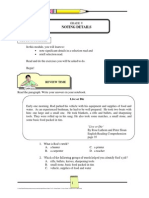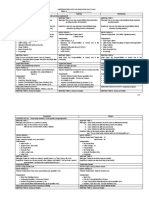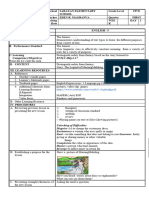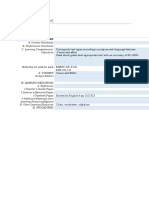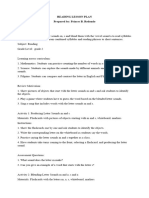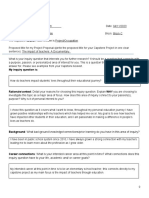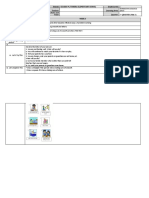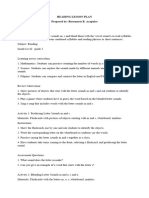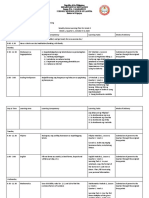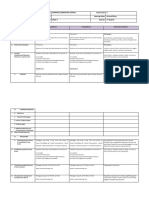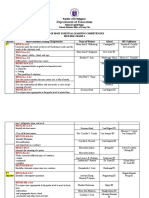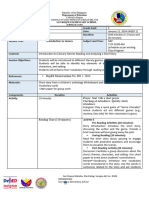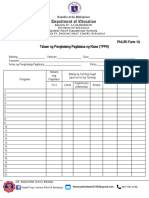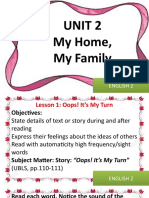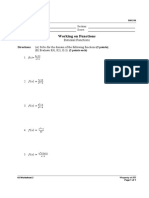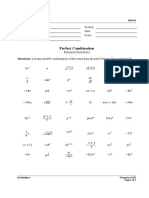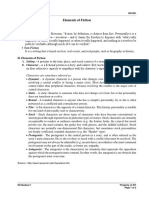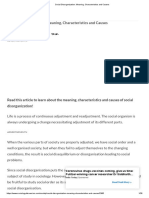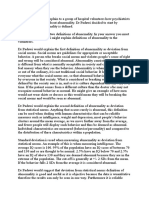0 ratings0% found this document useful (0 votes)
325 viewsUnit 3 - Lessons - 6-10 (Pp. 136-142)
Unit 3 - Lessons - 6-10 (Pp. 136-142)
Uploaded by
catherinerenanteThe document provides details of lesson plans for teaching English to second grade students. It includes 10 lessons targeting skills like oral language, reading comprehension, writing, and valuing family. Lesson plans focus on stories, poems, questioning words and writing simple stories. Procedures include activities like reading aloud, reciting, answering questions, group work and assessments. The goal is to help students improve English skills while instilling values of love and concern for family.
Copyright:
Attribution Non-Commercial (BY-NC)
Available Formats
Download as PDF, TXT or read online from Scribd
Unit 3 - Lessons - 6-10 (Pp. 136-142)
Unit 3 - Lessons - 6-10 (Pp. 136-142)
Uploaded by
catherinerenante0 ratings0% found this document useful (0 votes)
325 views7 pagesThe document provides details of lesson plans for teaching English to second grade students. It includes 10 lessons targeting skills like oral language, reading comprehension, writing, and valuing family. Lesson plans focus on stories, poems, questioning words and writing simple stories. Procedures include activities like reading aloud, reciting, answering questions, group work and assessments. The goal is to help students improve English skills while instilling values of love and concern for family.
Original Title
Unit 3_Lessons_6-10 (pp. 136-142)
Copyright
© Attribution Non-Commercial (BY-NC)
Available Formats
PDF, TXT or read online from Scribd
Share this document
Did you find this document useful?
Is this content inappropriate?
The document provides details of lesson plans for teaching English to second grade students. It includes 10 lessons targeting skills like oral language, reading comprehension, writing, and valuing family. Lesson plans focus on stories, poems, questioning words and writing simple stories. Procedures include activities like reading aloud, reciting, answering questions, group work and assessments. The goal is to help students improve English skills while instilling values of love and concern for family.
Copyright:
Attribution Non-Commercial (BY-NC)
Available Formats
Download as PDF, TXT or read online from Scribd
Download as pdf or txt
0 ratings0% found this document useful (0 votes)
325 views7 pagesUnit 3 - Lessons - 6-10 (Pp. 136-142)
Unit 3 - Lessons - 6-10 (Pp. 136-142)
Uploaded by
catherinerenanteThe document provides details of lesson plans for teaching English to second grade students. It includes 10 lessons targeting skills like oral language, reading comprehension, writing, and valuing family. Lesson plans focus on stories, poems, questioning words and writing simple stories. Procedures include activities like reading aloud, reciting, answering questions, group work and assessments. The goal is to help students improve English skills while instilling values of love and concern for family.
Copyright:
Attribution Non-Commercial (BY-NC)
Available Formats
Download as PDF, TXT or read online from Scribd
Download as pdf or txt
You are on page 1of 7
136
Lesson 6: Which Word?
Target Skills:
Oral Language:
Participate in group and individual oral interpretation of short poems, rhymes, and
stories
Recite known verses, short poems, and rhymes in English
Fluency:
Read aloud Grade 2 level text
Phonics and Word Recognition:
Match consonant blends/clusters sounds to their corresponding letters/letter patterns
Grammar:
Use question words (who, what, where, when, and why)
Listening Comprehension:
Participate in the retelling of poems / stories
Reading Comprehension:
Make connection of text to self
Writing and Composition:
Write a simple story
Attitude Towards Reading:
Retell familiar stories to other children
Instill the value of concern for family and the future generation
Objectives:
Answer Wh- questions
Identify and describe the main character
Sequence events
Participate in the retelling of poems / stories
Subject Matter: Sequencing Events
Materials: pictures, ash cards
Value Focus: Love / Concern for family and the future generation
Procedure:
Pre-Assessment: (Refer to LM, pp. 260-261, Lets Try)
Key to Correction:
A. Have the pupils name each object and write its beginning sound.
1. bl 2. cl 3. pl 4. gl
5. bl 6. 7. gl 8. sl
B. 9. Where 10. Who 11. Who 12. Why
13. How 14. When 15. What
C. 16. 17. 18. 19. 20.
137
Motivation:
Show a picture of a crippled person or one who is physically
handicapped.
Ask: Do you know someone who is like him/her who is talented
or who became successful despite his/her disability?
What are the different ways of showing ones concern for
others at home or in school?
Let the pupils choose their answer from the pictures drawn
on the pieces of a broken heart and paste each part until the
heart is completed.
Presentation:
Unlocking of Difcult Words through pictures or action:
crippled limp
Motive Question:
Ask: How did Wilma become an Olympic winner?
Read Aloud: (Refer to LM, pp. 262-263, Lets Listen)
Comprehension Questions: (Refer to LM, p. 263, Lets Answer)
Group Work: (Refer to LM, p. 264, We Can Do It)
Application:
Ask the pupils to retell the story according to the importance of events and using the
completed timeline.
Lesson 7: Talented Too
Objectives:
Identify and describe the characters of the story
Retell the story heard
Subject Matter: Story Retelling
Materials: pictures
Value Focus: Love and concern for others
Procedure:
Motivation:
Ask: Do you want to become a champion like Wilma?
In which of the following areas do you want to succeed?
sports music or singing painting
dancing other forms of art cooking
138
Presentation:
Hold a talent show in class.
Have some volunteer pupils show their talent.
Choose the pupils who have the best talent. Help them recall and share the important
events in their lives which led them to develop such talent by completing the following
statements:
I am ________________.
I am a good __________. (pupils talent)
When I was ___ years old, ____________ trained me how to __________well.
I won _____ place when I joined the __________ contest. (optional statement)
Using the given details, write the pupils story on the experience chart.
Let the pupils read the completed story.
Ask: Why is it important to show our love and concern for other people?
(We help people become successful if we show our love/concern for and support to
them.)
Have pupils recall the story of Wilma.
Using the pictures on page 264 of the LM, recall the important events or key points in
the story.
Group Work: (Refer to LM, p. 265, We Can Do It)
Evaluation: (Refer to LM, p. 265, I Can Do It)
Lesson 8: Tell Me Who, What, Where, When, Why, and How
Objectives:
Use question words or interrogatives (who, what, where, when ,why, how)
Write a simple story
Subject Matter: Using Interrogatives (Who, What, Where, When, Why, How)
Materials: pictures, puzzle
Value Focus: Love / Concern for family and the future generation
Procedure:
Review:
Have pupils recall the story of Wilma.
Have them identify the important events in the story using the pictures.
(Refer to LM, p. 264)
Motivation:
Ask: Do you also want to be a popular athlete like Wilma?
Why? How many silver or gold medals would you like to win? How will you do it?
139
Presentation:
Have pupils read the following details and questions. Let the pupils underline the words
or phrase in the sentence that answers each question. (Refer to LM, p. 266, Lets Aim)
1. Wilma was crippled by polio. (Who was crippled by polio?)
2. The doctor told her parents that she would never walk again because she was
crippled by polio. (Why did the doctor say that she would never walk again?)
3. Her parents gave her heat and water treatment. (What did her parents give her?)
4. When she was 11 years old, she played basketball. (When did she play basketball?)
5. She won three gold medals in the Summer Olympics in Rome. (Where did she win
the Summer Olympics gold medals?)
6. She became a real winner through the love and concern of her family. (How did
she become a real winner?)
Ask: What words / interrogatives are we going to use if we want to ask about a person? A
thing or an idea? Time? Place? Reason? (Refer to LM, pp. 266-267, Lets Answer)
What specic details do we use to answer questions that begin with the following?
Who? (person)
What? (thing or idea)
Where? (place)
When? (time)
Why? (reason)
How? (ways or means)
Say: Choose a partner. Get to know more about him/her by asking and answering
questions that begin with who, what, where, when, why, and how.
Generalization:
When do we use the interrogatives?
We use interrogatives to ask for information.
Who is used when asking about persons.
What is used when asking about things, ideas, or events.
Where is used when asking about places.
When is used when asking about time.
Why is used when asking about reasons or causes.
How is used when asking about the way a thing is done.
Application: (Refer to LM, p. 268, I Can Do It)
140
Lesson 9: I Love My Family and Everyone in School
Objectives:
Read aloud Grade 2 level text
Recite known verses, poems, rhymes, and stories in English
Match consonant blends/clusters sounds with their corresponding letters/letter patterns
Instill the value of love/concern for family and the future generation
Subject Matter: Love / Concern for family and the future generation
Consonant Clusters and Blends
Materials: pictures
Value Focus: Love / Concern for family and the future generation
Procedure:
Drill:
Have pupils complete each word with the appropriate initial consonant blends.
_ _ _ aw
_ _ awn
_ _ _ ap
_ _ op
Review:
Ask: What made Wilma a real winner?
How did her family members show their love and concern for her?
Motivation:
Ask: How will you show your love and concern for your family and classmates?
Draw a heart on the board like the one on LM, p. 269, Get Set.
Have pupils write their answers around the heart.
Presentation:
Let the pupils read the poem My Family, My Treasure by Amcy M. Esteban.
(Refer to LM, p. 269, Lets Aim)
Have the pupils answer the comprehension questions.
(Refer to LM, p. 269, Lets Answer)
Let the pupils read the poem again.
by the whole class
by group
individually
Group Work:
Ask the pupils to complete the Venn diagram. (Refer to LM, p. 270, We Can Do It)
Have pupils list all the words in the poem which have consonant clusters/blends.
(truly, treasure)
141
Application:
A. Let the pupils do the activity. (Refer to LM, p. 270, I Can Do It)
B. Have them give other words with consonant clusters/blends.
(Write the pupils answers on the board and have them read the words.)
Have them arrange the following letters to form words with consonant clusters/blends.
1. r d m u ___________
2. n t o r f ___________
3. r e s s d ___________
4. l e v r a g ___________
5. p o r u g ___________
Evaluation:
Have pupils write the word with consonant blends.
1. care crash case cash
2. pay say play pain
3. trap tap tape tip
4. crib ribs hip lips
5. dove drove done dont
Lesson 10: Writing a Simple Story
Objectives:
Write a simple story
Instill the value of concern for family and the future generation
Subject Matter: Writing a Simple Story
Materials: ash cards
Value Focus: Concern for family and the future generation
Procedure:
Drill:
Conduct a pronunciation drill using ash cards for the following words:
/gr/ /str/ /rk/
grow strip work
greet strong park
grand string bark
green street spark
Review:
Ask the pupils to recite the poem My Family, My Treasure again.
Motivation: (Refer to LM, p. 271, Get Set)
142
Presentation:
Choose a sample of the pupils output from the Get Set activity.
Using this, guide the pupils in answering the following questions.
(Write the pupils answers on the board to form a simple story.)
1. Who are you?
I am __________.
2. Who is your loved one?
My loved one is_________. or My loved ones are _______.
3. Why do you love her/him?
I love him/her because ________.
4. How do you show your love for him/her?
I show my love for him/her by_______.
Application: (Refer to LM, pp. 271-272, I Can Do It)
Evaluation: (Refer to LM, p. 272, Measure My Learning)
Evaluate pupils written work using the following rubric:
Indicators Ior each
question
Score
5 4 3 2 1 0
(
A
l
l
c
o
n
d
i
t
i
o
n
s
a
r
e
m
e
t
.
)
(
1
o
I
t
h
e
i
n
d
i
c
a
t
o
r
s
i
s
n
o
t
m
e
t
.
)
(
2
i
n
d
i
c
a
t
o
r
s
a
r
e
n
o
t
m
e
t
o
r
2
e
r
r
o
r
s
a
r
e
o
b
s
e
r
v
e
d
.
)
(
S
o
m
e
i
n
d
i
c
a
t
o
r
s
a
r
e
m
e
t
b
u
t
w
i
t
h
3
e
r
r
o
r
s
.
)
(
O
n
l
y
1
i
n
d
i
c
a
t
o
r
i
s
m
e
t
a
n
d
w
i
t
h
e
r
r
o
r
s
.
)
(
N
o
a
n
s
w
e
r
w
a
s
p
r
o
v
i
d
e
d
.
)
1. Complete name is
written. The use oI
capital letters is
properly observed.
2. Complete name oI
loved one/ones
is/are correctly
written. The use oI
capital letters is
properly observed.
3. Reasonable
answers are
provided. The
words used are
correctly spelled.
4. Two or more
reasonable answers
are given. The
words used are
correctly spelled.
Total Score (20 points)
Agreement: (Refer to LM, p. 273, Agreement)
You might also like
- (Ebook PDF) Staffing Organizations 8th Edition by Heneman Download PDFDocument43 pages(Ebook PDF) Staffing Organizations 8th Edition by Heneman Download PDFnishomeyvisNo ratings yet
- Tiered Lesson PlanDocument7 pagesTiered Lesson PlanDomagoj Bosn100% (3)
- 1-Noting Details 12-14 PDFDocument14 pages1-Noting Details 12-14 PDFcatherinerenante100% (12)
- PNU ProfED JWRADocument244 pagesPNU ProfED JWRACharlotte AntonioNo ratings yet
- Kindergarten Lesson Plan Week 10Document16 pagesKindergarten Lesson Plan Week 10EfprelNo ratings yet
- Unit 3 - Lessons - 16-20 (Pp. 151-156)Document6 pagesUnit 3 - Lessons - 16-20 (Pp. 151-156)catherinerenante100% (1)
- TG Math Grade2 PDFDocument517 pagesTG Math Grade2 PDFcatherinerenante88% (25)
- UnionBank English Grade 2 Unit 3 PDFDocument128 pagesUnionBank English Grade 2 Unit 3 PDFcatherinerenante67% (3)
- Daily Lesson LOG School: Matindeg Elementary School Grade Level: FOUR Teacher: WARREN M. SINCO English Teaching Dates/Time: Week 3 Quarter: 2NDDocument5 pagesDaily Lesson LOG School: Matindeg Elementary School Grade Level: FOUR Teacher: WARREN M. SINCO English Teaching Dates/Time: Week 3 Quarter: 2NDWarren Millo SincoNo ratings yet
- Q2 Week5-7 ForDocument33 pagesQ2 Week5-7 Forjoy galangNo ratings yet
- Difficulty in Basic Learning and Applying Knowledge ChecklistDocument5 pagesDifficulty in Basic Learning and Applying Knowledge ChecklistGENEVIE AVELLANANo ratings yet
- GSP ProgramDocument5 pagesGSP ProgramRickNo ratings yet
- Melc - Grade 4 Health - Q3 and Q4Document3 pagesMelc - Grade 4 Health - Q3 and Q4SALIHAH MARJANNAH SUBA100% (1)
- Quarter 3, Week 1 English Inkay - PeraltaDocument47 pagesQuarter 3, Week 1 English Inkay - PeraltaPatrick EdrosoloNo ratings yet
- ENGLISH Lesson Exemplar WEEK7Document5 pagesENGLISH Lesson Exemplar WEEK7Iza Mae AlunanNo ratings yet
- Cot English 5-Reality-FantasyDocument4 pagesCot English 5-Reality-FantasyEden Ropia100% (1)
- g3 DLL q3 Week 6 MapehDocument3 pagesg3 DLL q3 Week 6 MapehPunang National High School 309166No ratings yet
- 2C2IA - Lesson PlanDocument13 pages2C2IA - Lesson PlanChristian Mespher Amposta Hernandez0% (1)
- English 5 - DLP Q2W7D1Document4 pagesEnglish 5 - DLP Q2W7D1Babylene GasparNo ratings yet
- FILIPINO 1 - Quarter 3 - Week 8 (COT)Document9 pagesFILIPINO 1 - Quarter 3 - Week 8 (COT)Actions Avon100% (1)
- School Reading Literacy Assessment Results: School Id: School Name: Number of Learners EnrolledDocument6 pagesSchool Reading Literacy Assessment Results: School Id: School Name: Number of Learners EnrolledMar StoneNo ratings yet
- DLP Math3 Q3 WK8Document10 pagesDLP Math3 Q3 WK8Precious RamosNo ratings yet
- Contextualized Lesson Plan in Mathematics 4Document4 pagesContextualized Lesson Plan in Mathematics 4EDITHA CASILANNo ratings yet
- Plural Form of A Regular NounDocument31 pagesPlural Form of A Regular Nounteacheranne.atworkNo ratings yet
- Department of Education: Simplified Melc-Based Weekly Budget of Lessons in Mtb-Mle 2Document6 pagesDepartment of Education: Simplified Melc-Based Weekly Budget of Lessons in Mtb-Mle 2Cherryl Virtudazo DaguploNo ratings yet
- (Enter Post Title Here) : I. ObjectivesDocument4 pages(Enter Post Title Here) : I. Objectiveslovely venia m joven100% (1)
- Flat Filipino Narrative Del PilarDocument1 pageFlat Filipino Narrative Del PilarCristita Macaranas VigoNo ratings yet
- Basa Pilipinas QTR 2Document254 pagesBasa Pilipinas QTR 2Michelle DanielaNo ratings yet
- English 3 Intervention PlanDocument2 pagesEnglish 3 Intervention PlanNoel Banda100% (1)
- BTS LAC Session 1.2Document15 pagesBTS LAC Session 1.2Marrielle Joshua OmamalinNo ratings yet
- Reading Lesson Plan 1Document3 pagesReading Lesson Plan 1Rosemarie AcapulcoNo ratings yet
- English: Quarter 2 - Module 7: Week 8 Using Different Sources of Information in ReadingDocument21 pagesEnglish: Quarter 2 - Module 7: Week 8 Using Different Sources of Information in ReadingArcanus LorreynNo ratings yet
- Mathematics: Quarter 3 - Module 1: Pagkilaea Sa Mga Numero Nga Waki Ag ParesDocument16 pagesMathematics: Quarter 3 - Module 1: Pagkilaea Sa Mga Numero Nga Waki Ag ParesEdlyn Aranas RegnoNo ratings yet
- Capstone Project ProposalDocument5 pagesCapstone Project Proposalapi-654571590No ratings yet
- Week 6 - Grade 3 at HomeDocument4 pagesWeek 6 - Grade 3 at Homeapi-506381744No ratings yet
- En4Ss-Iiic-1.4: "Big Feet-Big Heart" Adapted From Chicken Soup For The Soul by Jack Canfield and Mark HanselDocument4 pagesEn4Ss-Iiic-1.4: "Big Feet-Big Heart" Adapted From Chicken Soup For The Soul by Jack Canfield and Mark HanselmarifeNo ratings yet
- Group 3: Joel Segubience Lucita Armecin Rosalinda GuicoDocument9 pagesGroup 3: Joel Segubience Lucita Armecin Rosalinda GuicoJoel SegubienceNo ratings yet
- COT1 - Verb Tenses - OngcoDocument7 pagesCOT1 - Verb Tenses - OngcoJane ChristineNo ratings yet
- Homeroom Guidance Program ModuleDocument4 pagesHomeroom Guidance Program ModuleMary Joy Erana100% (2)
- Cot-Filipino - PangngalanDocument4 pagesCot-Filipino - PangngalanEdz Abrea Gabona100% (1)
- Div Memo 75 2021Document13 pagesDiv Memo 75 2021Princess Joy Revalo100% (1)
- Patrol 3Document16 pagesPatrol 3helaizaherrera100% (1)
- Lesson Plans For Multigrade Classes Grades 5 and 6: Tomas de Leon DocaDocument2 pagesLesson Plans For Multigrade Classes Grades 5 and 6: Tomas de Leon DocaEvan Maagad Lutcha100% (1)
- DETAILED LESSON PLAN IN MATHEMATICS GRADE 2 - Roselyn CabansagDocument8 pagesDETAILED LESSON PLAN IN MATHEMATICS GRADE 2 - Roselyn CabansagRoselyn Mhikay Cabansag100% (2)
- Reading Lesson Plan 1Document3 pagesReading Lesson Plan 1Rosemarie Acapulco100% (1)
- Republic of The Philippines Department of Education Region Iva-Calabarzon Schools Division Office of Laguna District of MajayjayDocument4 pagesRepublic of The Philippines Department of Education Region Iva-Calabarzon Schools Division Office of Laguna District of MajayjayClary Breganza Halili100% (2)
- Sim Science 3Document21 pagesSim Science 3Jane Bunuan SaludaresNo ratings yet
- Phil Iri School FormDocument19 pagesPhil Iri School FormAlejandra Lagman CuevaNo ratings yet
- Kab Scout AdvancementDocument16 pagesKab Scout AdvancementJONNA BERNARDINONo ratings yet
- Least Learned Competencies: San Jose Elementary SchoolDocument2 pagesLeast Learned Competencies: San Jose Elementary SchoolDHARYL L. PIANDIONG100% (3)
- Week 7Document5 pagesWeek 7Evan Maagad LutchaNo ratings yet
- DLP SuffixesDocument2 pagesDLP SuffixesRecaNo ratings yet
- Grade 3 RibbonsDocument6 pagesGrade 3 RibbonsPRINCESS JARAH-MIA REDAONo ratings yet
- Least LearnedDocument17 pagesLeast LearnedNoriel Escorel MabatoNo ratings yet
- PronounsDocument3 pagesPronounsnorlyn A. LevisteNo ratings yet
- MTB MLE GRADE 3 NEW LC With DataDocument4 pagesMTB MLE GRADE 3 NEW LC With DataJinky Junio0% (1)
- Grade 5 NRP With FormatDocument22 pagesGrade 5 NRP With Formatcollen corminal100% (1)
- Sample Works PDFDocument18 pagesSample Works PDFRemryan R. RebutazoNo ratings yet
- Group Screening Test Form Per ClassDocument4 pagesGroup Screening Test Form Per Classjhe maligayaNo ratings yet
- Q1 - WK2 - DLL - Mapeh 6 UpdatedDocument8 pagesQ1 - WK2 - DLL - Mapeh 6 UpdatedLaine Agustin SalemNo ratings yet
- English Unit Ii Lesson 1 11Document192 pagesEnglish Unit Ii Lesson 1 11Clarine Jane NuñezNo ratings yet
- English 3 - 1st Quarter DLL Week 5Document7 pagesEnglish 3 - 1st Quarter DLL Week 5daisy.fajardo001No ratings yet
- Lesson Plan in Mother Tongue 2: Ini, Iyan, ItoDocument2 pagesLesson Plan in Mother Tongue 2: Ini, Iyan, ItoJenelyn ApinadoNo ratings yet
- Learners Progress Report Card For The New Normal S.Y. 2021 - 2022Document4 pagesLearners Progress Report Card For The New Normal S.Y. 2021 - 2022Jessel Galicia100% (1)
- More On Time and Money: Directions: Solve The Following ItemsDocument1 pageMore On Time and Money: Directions: Solve The Following ItemscatherinerenanteNo ratings yet
- Activity 3Document1 pageActivity 3catherinerenanteNo ratings yet
- 05 Handout 1Document1 page05 Handout 1catherinerenanteNo ratings yet
- Seven (7) Principles of Effective Public SpeakingDocument4 pagesSeven (7) Principles of Effective Public SpeakingcatherinerenanteNo ratings yet
- Mesmerized and Annuitized: Directions: Solve The Following ItemsDocument1 pageMesmerized and Annuitized: Directions: Solve The Following ItemscatherinerenanteNo ratings yet
- 03 Handout 1Document1 page03 Handout 1catherinerenanteNo ratings yet
- 07 Handout 1Document7 pages07 Handout 1catherinerenanteNo ratings yet
- 01 Handout 1Document4 pages01 Handout 1catherinerenanteNo ratings yet
- 03 Worksheet 1Document1 page03 Worksheet 1catherinerenanteNo ratings yet
- 01 Handout 1Document4 pages01 Handout 1raulNo ratings yet
- 03 Handout 1Document5 pages03 Handout 1catherinerenanteNo ratings yet
- 03 Activity 1Document2 pages03 Activity 1catherinerenanteNo ratings yet
- 03 Handout 1Document2 pages03 Handout 1catherinerenanteNo ratings yet
- Push Mo Yan Friend: Inverse FunctionsDocument1 pagePush Mo Yan Friend: Inverse FunctionscatherinerenanteNo ratings yet
- 02 Worksheet 2Document1 page02 Worksheet 2catherinerenanteNo ratings yet
- Context. Quezon City, Philippines. The Publishing House.: Property of STIDocument1 pageContext. Quezon City, Philippines. The Publishing House.: Property of STIcatherinerenanteNo ratings yet
- 02 Activity 1Document1 page02 Activity 1catherinerenanteNo ratings yet
- 02 Handout 1Document2 pages02 Handout 1catherinerenante100% (1)
- TG Mtb-Mle Grade2 PDFDocument297 pagesTG Mtb-Mle Grade2 PDFcatherinerenante64% (14)
- I. Tools and Equipment in The KitchenDocument3 pagesI. Tools and Equipment in The KitchencatherinerenanteNo ratings yet
- LM ENGLISH GRADE2 Part2 PDFDocument254 pagesLM ENGLISH GRADE2 Part2 PDFcatherinerenante100% (1)
- 02 Activity 2Document1 page02 Activity 2catherinerenanteNo ratings yet
- WORKBOOK English-6Document212 pagesWORKBOOK English-6catherinerenanteNo ratings yet
- 2013 - 2014 Post Nat Math ViDocument1 page2013 - 2014 Post Nat Math VicatherinerenanteNo ratings yet
- LM ENGLISH GRADE2 Part1 PDFDocument250 pagesLM ENGLISH GRADE2 Part1 PDFcatherinerenanteNo ratings yet
- UnionBank English Grade 2 Unit 4 PDFDocument237 pagesUnionBank English Grade 2 Unit 4 PDFcatherinerenante100% (1)
- Nursing Care Plan: Assessment Nursing Diagnosis Scientific Rationale Objectives Interventions Expected OutcomesDocument2 pagesNursing Care Plan: Assessment Nursing Diagnosis Scientific Rationale Objectives Interventions Expected OutcomesAsdfghjlNo ratings yet
- Narra, Jennifer A. DLLDocument3 pagesNarra, Jennifer A. DLLJennifer NarraNo ratings yet
- Evidence (Stanford Encyclopedia of Philosophy)Document25 pagesEvidence (Stanford Encyclopedia of Philosophy)juanNo ratings yet
- Social Disorganization - Meaning, Characteristics and CausesDocument25 pagesSocial Disorganization - Meaning, Characteristics and CausesktkiNo ratings yet
- Malo ArticleDocument6 pagesMalo Articleishita parekhNo ratings yet
- Reference With No AuthorDocument8 pagesReference With No Authorezknbk5h100% (2)
- Information To UsersDocument389 pagesInformation To Usersfiratvyl8882No ratings yet
- An Evaluation of Sustainable Construction Practises An InvesDocument25 pagesAn Evaluation of Sustainable Construction Practises An InvesStephen JohnNo ratings yet
- Describe and Evaluate Two Definitions of AbnormalityDocument3 pagesDescribe and Evaluate Two Definitions of AbnormalityjenikaNo ratings yet
- EC - - 34360 - 教學計畫Document3 pagesEC - - 34360 - 教學計畫余思懷No ratings yet
- English Project Class XIDocument11 pagesEnglish Project Class XI8f02.abhijeetpulkitNo ratings yet
- Course Assessment 3 Week 1Document7 pagesCourse Assessment 3 Week 1Rene Jan HilberoNo ratings yet
- Soal UTS Bahasa Inggris SD Semester Genap Kelas 4Document3 pagesSoal UTS Bahasa Inggris SD Semester Genap Kelas 4Siti Machrusatul AinNo ratings yet
- PR2 Related Lit Lesson 2Document27 pagesPR2 Related Lit Lesson 2DonabelEscotaEspañoNo ratings yet
- Chapter I: The Problem and Its BackgroundDocument3 pagesChapter I: The Problem and Its BackgroundRolando E. CaserNo ratings yet
- Performance Management at Network Solutions IncDocument6 pagesPerformance Management at Network Solutions IncDalreen GamageNo ratings yet
- Claim For Qualification PayDocument17 pagesClaim For Qualification PaymsjhaNo ratings yet
- Request On Borrowing of BooksDocument3 pagesRequest On Borrowing of BooksYasmine Lerma AlvaNo ratings yet
- Proskills ResumeDocument12 pagesProskills Resumeapi-246286861No ratings yet
- Introduction To Sociology (SOC 101-006) Drexel University Spring 2020 Randel 121 Tuesday/Thursday 11am-12:20pmDocument7 pagesIntroduction To Sociology (SOC 101-006) Drexel University Spring 2020 Randel 121 Tuesday/Thursday 11am-12:20pmVõ Lan PhươngNo ratings yet
- Btech New PuneDocument2 pagesBtech New PunerichashyampatilNo ratings yet
- Report - Online Learning SystemDocument42 pagesReport - Online Learning SystemBhargav JaniNo ratings yet
- Final Coaching BulletsDocument3 pagesFinal Coaching BulletsJulie Ann GinesNo ratings yet
- Ang Organisasyon NG SimbahanDocument5 pagesAng Organisasyon NG SimbahanrhonamaeNo ratings yet
- Bottom LineDocument2 pagesBottom LineLouwegie GrabilloNo ratings yet
- Translation Has Been Defined in Many Ways by Different Writers in The FieldDocument2 pagesTranslation Has Been Defined in Many Ways by Different Writers in The FieldDzikru AminullohNo ratings yet
- The Problem of Immigrant and Nastalgia in The Novel of Uma Parameswaran's "Dear Deedi, My Sister"Document5 pagesThe Problem of Immigrant and Nastalgia in The Novel of Uma Parameswaran's "Dear Deedi, My Sister"S. m.s.No ratings yet


